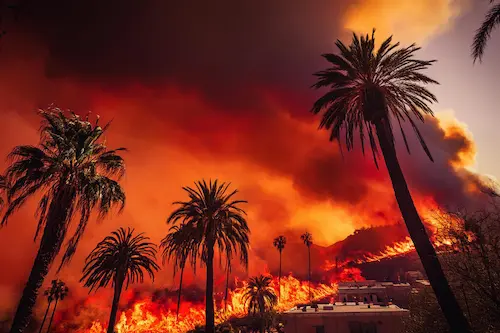Best practices for rebuilding after a wildfire: Lessons from Pacific Palisades

Wildfires are a devastating force of nature that can leave entire communities in ruins. The recent wildfires in Pacific Palisades serve as a reminder of the destruction these events can cause.
However, they also provide an opportunity to learn valuable lessons about resilience, planning, and sustainable rebuilding practices.
When rebuilding after a wildfire, it is crucial to consider safety, environmental impact, and long-term sustainability to create a more fire-resistant and resilient community.
1. Assessing Damage and Ensuring Safety
Before beginning the rebuilding process, it is essential to assess the extent of the damage and ensure the area is safe for reconstruction. Some key steps include:
Working with Professionals: Structural engineers and inspectors should evaluate buildings to determine what can be salvaged and what needs complete reconstruction.
Clearing Debris Safely: Ash, soot, and debris from wildfires can contain hazardous materials. Proper cleanup techniques, such as wearing protective gear and using specialized removal services, should be employed.
Checking for Utility Damage: Gas, electricity, and water lines may have been compromised. Working with utility providers to restore services safely is essential.
2. Understanding Fire-Resistant Construction Materials
Building with fire-resistant materials can significantly reduce the risk of future wildfire damage. Lessons from Pacific Palisades highlight the importance of:
Fire-Resistant Roofing: Using Class A fire-rated roofing materials such as metal, clay tiles, or asphalt shingles can prevent ember penetration.
Non-Combustible Siding: Fiber cement, stucco, and brick are preferable to wood siding, which is highly flammable.
Tempered Glass Windows: Double-paned, tempered glass windows help prevent breakage from heat exposure and ember intrusion.
Ember-Resistant Vents: Installing ember-resistant vents with fine mesh screens can keep embers from entering attics and crawl spaces.
3. Creating Defensible Space around Homes
A critical lesson from Pacific Palisades is the importance of defensible space. Proper landscaping and vegetation management can prevent wildfires from spreading to structures. Best practices include:
Zone 1 (0-5 feet from structures): Keep this area free of combustible materials, including dry leaves, mulch, and wooden furniture.
Zone 2 (5-30 feet from structures): Use fire-resistant plants, space trees appropriately, and maintain a well-irrigated landscape.
Zone 3 (30-100 feet from structures): Reduce vegetation density, trim tree branches, and create firebreaks to slow down the spread of flames.
4. Implementing Fire-Resilient Community Planning
Wildfire recovery should involve not just individual homeowners but also community-wide planning to enhance overall resilience. Effective strategies include:
Updated Building Codes: Pacific Palisades has adopted stricter building codes to minimize wildfire damage. Communities rebuilding after a wildfire should incorporate similar fire-resistant regulations.
Evacuation Routes: Designing clear, accessible evacuation routes and emergency plans ensures residents can safely leave during future wildfires.
Community Firebreaks: Strategically placed firebreaks, such as cleared areas or roads, can help prevent the spread of wildfires.
Water Supply Enhancements: Installing additional water storage tanks and ensuring fire hydrants are accessible and functional can aid firefighting efforts.
5. Leveraging Government and Insurance Support
Rebuilding after a wildfire can be financially overwhelming. Taking advantage of available resources can ease the burden:
FEMA Assistance: Homeowners and businesses may qualify for disaster relief grants and low-interest loans.
Insurance Claims: Documenting damage thoroughly and working closely with insurance providers ensures proper compensation for rebuilding.
State and Local Programs: Many state governments offer wildfire recovery assistance, including grants for fire-resistant retrofits.
6. Incorporating Sustainable and Energy-Efficient Practices
Wildfire recovery presents an opportunity to build smarter, more sustainable homes. Incorporating green building techniques can reduce long-term environmental impact and increase resilience. Best practices include:
Solar Power Integration: Solar panels with battery storage systems provide backup power during emergencies.
Energy-Efficient Insulation: High-quality insulation materials improve energy efficiency and fire resistance.
Rainwater Harvesting: Collecting rainwater reduces reliance on municipal water and provides an additional water source for firefighting.
Smart Home Technology: Automated sprinkler systems, fire alarms, and air quality monitors enhance safety and efficiency.
7. Community Education and Preparedness
Education plays a crucial role in preventing future wildfire disasters. Homeowners and communities must remain informed about:
Wildfire Behavior: Understanding how wildfires spread helps residents take proactive measures to protect their properties.
Emergency Preparedness: Having a wildfire emergency kit, evacuation plan, and communication strategy ensures readiness in case of another fire.
Fire-Resistant Landscaping Workshops: Offering community workshops on defensible space and fire-resistant landscaping encourages widespread adoption of best practices.
Rebuilding after a wildfire is a complex process, but the lessons from Pacific Palisades highlight the importance of planning, resilience, and sustainable practices.
By incorporating fire-resistant materials, creating defensible space, implementing community-wide safety measures, and leveraging available resources, affected communities can rebuild stronger and safer.
The goal is not just to recover but to prepare for the future, ensuring that homes and businesses stand resilient against the increasing threat of wildfires.